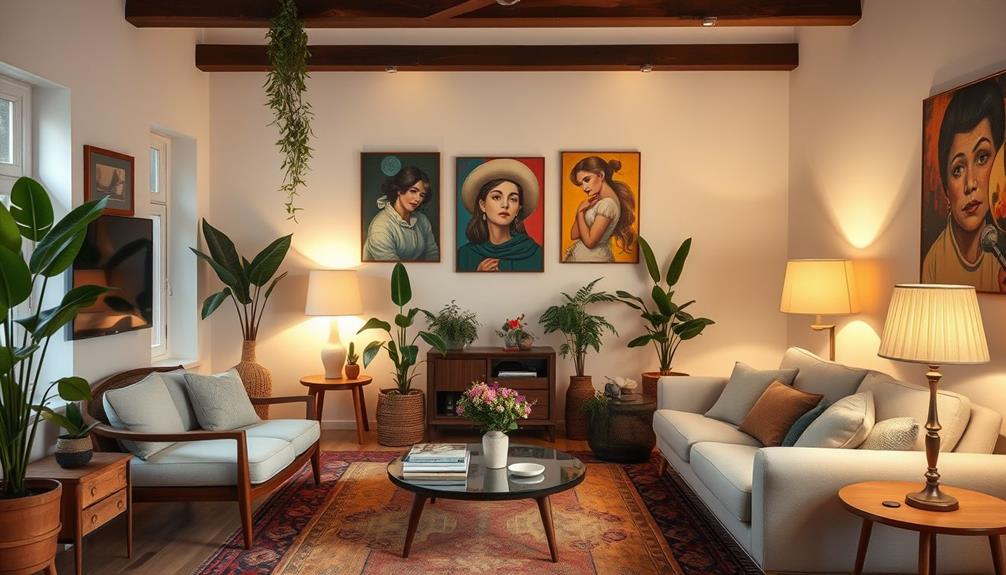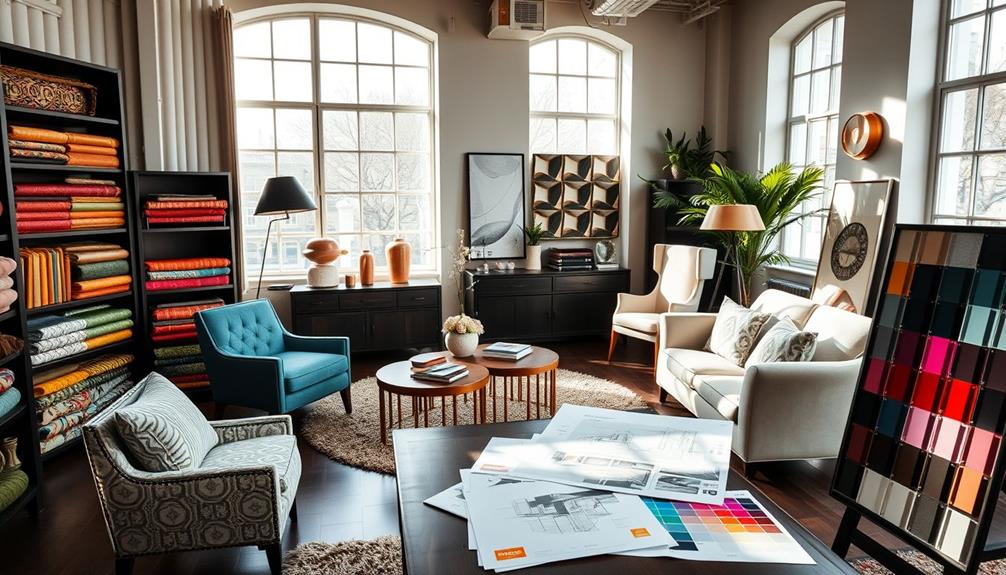You can easily interior design your home by starting with a clear budget and defining your style. Create a mood board filled with inspiration, colors, and textures that resonate with you. Measure your space and consider layout—maintain walking space and visualize furniture placement. Choose versatile furniture pieces that combine comfort and function. Select a color palette that reflects your personality and test samples in different lighting. Finally, personalize your space with meaningful decor and accessories that tell your story. With these steps, your home will truly feel like you, and there's much more to explore ahead. Here are a few additional tips for home interior design. Consider incorporating natural elements such as plants or wooden accents to bring a sense of tranquility and warmth to your space. Don’t be afraid to mix and match patterns and textures to add visual interest, but be mindful of balance and harmony. Lastly, don’t rush the process. Take your time in finding the right pieces and creating a home that reflects your unique style and personality.
Key Takeaways
- Establish a budget by categorizing expenses and tracking costs to avoid overspending during the design process.
- Take accurate measurements and plan layouts to ensure furniture fits well and maintains comfortable walking space.
- Create a mood board with colors, textures, and inspirations to visualize the desired aesthetic and guide design choices.
- Select versatile foundation furniture that prioritizes comfort and quality, establishing a solid base for your interior design.
- Personalize your space with meaningful objects and art that reflect your values and interests, creating a genuine representation of yourself.
Budgeting and Planning
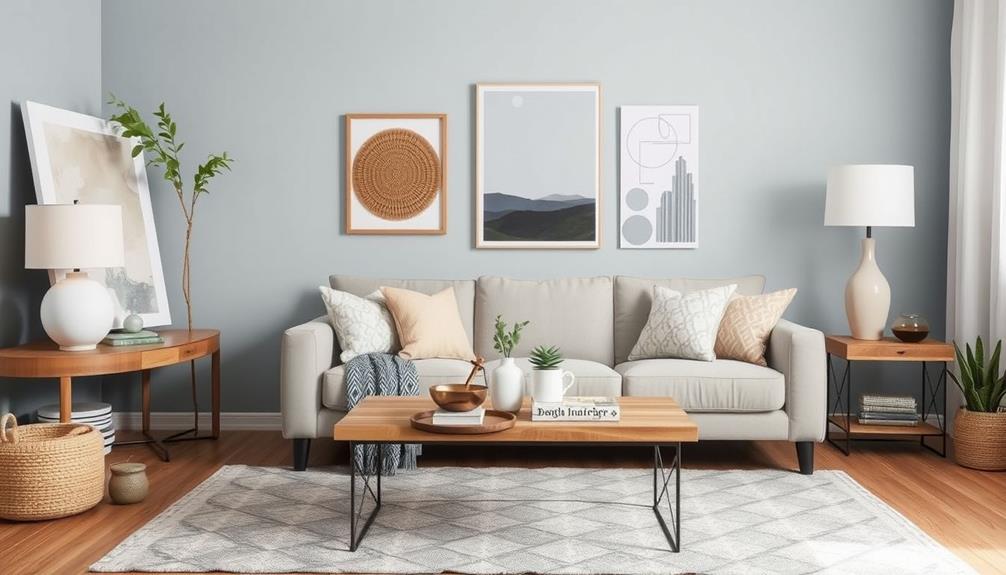
When it comes to budgeting and planning your interior design project, establishing a clear financial framework is vital. Start by categorizing your expenses into must-haves, nice-to-haves, and non-priorities. This approach helps you maintain financial control throughout the design process.
Using a spreadsheet is a smart way to track all project costs and estimates. Don't forget to add a cushion of 10-20% for unexpected expenses that may pop up during the remodel. To guarantee you're getting the best value for your budget, it's wise to obtain at least three bids from contractors, comparing both costs and quality.
Accurate measurements of your space are important as well. Consider using graph paper or digital floor planner apps to visualize furniture arrangements before making any purchases. This step can save you time and money in the long run.
As you move forward, regularly review total costs against your budget. This practice guarantees that your design stays within financial limits and allows for future changes as your tastes evolve.
Creating a Mood Board
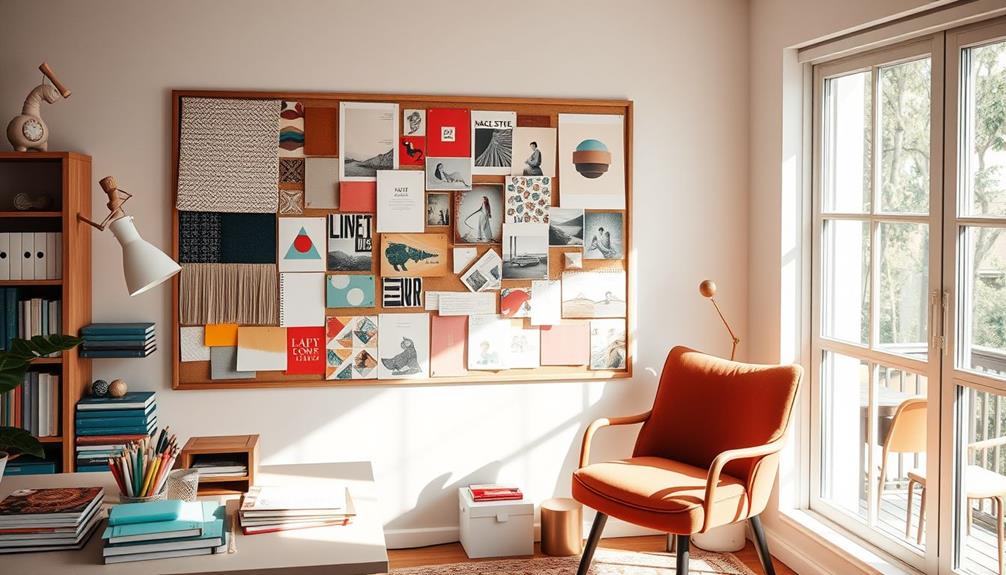
After establishing your budget and planning framework, it's time to bring your vision to life by creating a mood board. A mood board serves as a visual representation of your design ideas, helping you identify common themes and establish a cohesive aesthetic for your space.
Start by gathering design inspiration from platforms like Pinterest. Collect images, colors, and textures that resonate with your personal style.
Here are some essential components to include in your mood board:
- Color Palette: Choose colors that evoke the right mood for your space.
- Design Elements: Incorporate textures, patterns, and materials that speak to you.
- Springboard Object: Include a favorite painting or fabric to guide your overall design direction.
When assembling your mood board, combine existing items you wish to keep with new inspirations. This helps visualize how they can work together.
Remember to reflect on both functionality and emotional response; your mood board should reflect not just your aesthetic preferences but also the intended purpose of the space. This way, you'll create a design that truly feels like home.
Selecting Foundation Furniture

Selecting the right foundation furniture is crucial for establishing the overall vibe and functionality of your home. Opt for versatile pieces like neutral sofas and simple coffee tables that'll allow you to easily change your style over time without breaking the bank. Incorporating natural materials, such as wood and metal, can also enhance the aesthetic appeal of your foundation furniture while maintaining durability.
Prioritize comfort and quality because these key items dictate how your space feels. Before making any purchases, use painter's tape to visualize the dimensions and placement of larger furniture in your room. This will help guarantee they fit well without overwhelming the area.
Remember to research the recommended space between furniture to allow for comfortable movement and accessibility; aim for about 18 inches between seating pieces. A well-designed space should reflect trends like modern farmhouse decor that emphasize neutral tones and mixed textures.
Consider your foundation furniture as a long-term investment. Choose durable materials and timeless designs to withstand changing trends and personal tastes. A designer's touch can elevate your choices, but it's crucial to stay true to your comfort.
Choosing Color Schemes
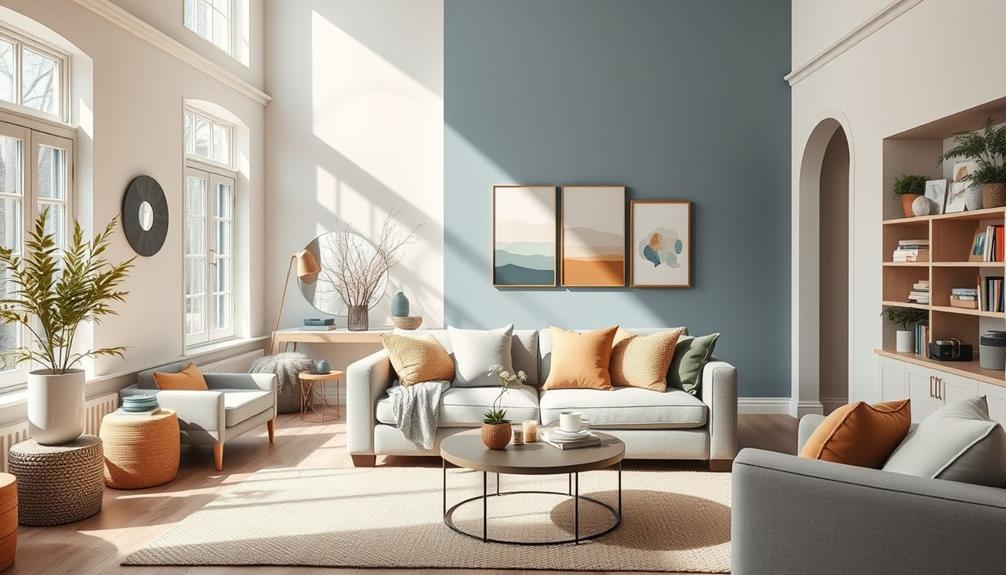
When choosing a color scheme, it's essential to understand how different colors affect mood and atmosphere.
Start by creating a cohesive palette that reflects your style, testing paint samples in various lighting to see how they interact with your furniture.
This process won't only help you select the perfect hues but also guarantee your space feels harmonious and inviting.
Understanding Color Psychology
Exploring color psychology can transform your interior design choices, as colors have a profound impact on emotions and atmosphere.
The right paint color can greatly influence how you feel or mood in a space, much like how healthy lifestyle blogs can inspire positive changes in your daily life. By understanding these effects, you can create environments that align with the purpose of each room.
Consider these aspects when choosing your color scheme:
- Warm Colors: Reds and yellows can stimulate energy and excitement, making them perfect for social spaces like living rooms.
- Cool Colors: Blues and greens promote calmness and relaxation, ideal for bedrooms and meditation areas.
- Neutrals: Shades like beige and gray provide a versatile backdrop, balancing bolder accent colors and creating a sense of tranquility.
Creating a Cohesive Palette
To create a cohesive color palette for your home, start by identifying a springboard object that resonates with your personal style, such as a vibrant piece of art or a patterned rug. This will help guide your color scheme and guarantee cohesiveness throughout the space.
Aim for a mix of 3-5 complementary colors in your palette, including a dominant color, a secondary color, and a few accent colors to add depth and interest. Additionally, consider how elements like stylish wall clocks can complement your color choices, adding both aesthetic appeal and functionality to your design.
Consider the psychological effects of your chosen colors. Blues and greens can evoke calmness, making them ideal for bedrooms, while yellows and oranges can energize living spaces. Using tools like digital color palette generators or paint chips can help you visualize how these colors interact in your home, ensuring they work well under different lighting conditions.
Don't forget to incorporate neutral colors into your palette. They provide a versatile backdrop that balances bolder hues and allows for easy updates with accessories.
Testing Paint Samples
Selecting the right paint colors is a vital step in bringing your cohesive palette to life. Testing paint samples effectively will help you make your space feel good and align with current design trends. Think about using a Graco FFLP Fine Finish Low Pressure Reversible Tip for a smoother application, which can enhance the overall finish of your paint job.
Here are some tips to keep in mind when testing:
- Apply swatches on different walls: Lighting can dramatically alter how a color looks throughout the day, so it's important to see how it changes with both natural and artificial light.
- Choose at least three shades: Subtle variations can greatly impact the mood of your space, so comparing different shades will help you find the perfect fit.
- Use larger sample patches: Aim for at least 1 square foot for a more accurate representation of the color's depth and richness, as small swatches can be misleading.
Don't forget to take into account the undertones of your chosen colors and how they interact with your existing decor.
Testing paint samples over time allows you to observe how each shade complements your home's overall aesthetic as the lighting shifts. This thoughtful approach guarantees that your final choices will truly enhance your space and reflect your style.
Personalizing Your Space

To truly make your space your own, start by reflecting on what embodies your personality and values.
Incorporate meaningful objects that tell your story, and don't shy away from changing things up as your tastes evolve over time.
This approach guarantees your home remains a genuine representation of who you are.
Reflect Your Personality
Your home should be a true reflection of who you are, showcasing your unique personality and experiences. To achieve this, start by identifying a "decorating hero"—a cherished item or piece of art that resonates with you. This can inspire your overall design choices and set the tone for your space.
Consider incorporating elements from island getaways that evoke relaxation and adventure, helping to create a serene atmosphere.
Consider these tips to personalize your home:
- Incorporate elements that showcase your hobbies, like bookshelves for reading or vibrant art from your travels.
- Use a mood board to visualize your personal aesthetic, ensuring colors and textures resonate with your lifestyle.
- Blend various styles and eras by mixing modern and vintage pieces to tell a story about your journey.
Incorporate Meaningful Objects
Personalizing your space goes beyond just reflecting your personality; it involves incorporating meaningful objects that resonate with your life experiences. By showcasing family heirlooms or travel souvenirs, you create a personal narrative that fosters emotional connections to your environment. Unique art pieces and photographs can enhance the aesthetic value of your rooms while telling your story.
Consider using a "springboard object," like a favorite rug or piece of furniture, to guide your color scheme and style. This approach guarantees a cohesive design that feels authentically yours. Here's a quick guide to help you choose meaningful objects:
| Object Type | Purpose | Example |
|---|---|---|
| Family Heirlooms | Create emotional connections | Vintage jewelry or furniture |
| Travel Souvenirs | Reflect life experiences | Framed postcards or masks |
| Unique Art Pieces | Enhance aesthetic value and narrative | Local artwork or photography |
Incorporate meaningful objects into your home, and you'll cultivate a space that evolves with your tastes, making it a dynamic representation of your identity.
Evolve With Time
Designing a home isn't a one-time event; it's an ongoing journey that evolves with your tastes and lifestyle. To truly personalize your space, embrace change and allow your home to reflect your personal journey. Here are some ways to keep your design fresh and relevant:
- Adaptable Furniture: Invest in versatile foundational pieces that can easily accommodate changing styles over time. For instance, consider furniture that maximizes space efficiency, much like the principles of tiny home living.
- Regularly Update Accessories: Change out pillows, artwork, and decor to align with new trends or seasonal moods.
- Celebrate Milestones: Let personal milestones inspire design tweaks, creating a space that tells your unique story.
As you evolve, stay attuned to emerging trends, like sustainable materials and smart home technology, to modernize your space while aligning with your values.
This dynamic approach guarantees your home remains a true reflection of who you're today. By thoughtfully integrating new finds and cherished heirlooms, you can create a harmonious balance of past and present.
Layout and Space Planning

Creating an effective layout and space plan is essential for transforming your home into a comfortable and functional environment. Start by utilizing apps like RoomSketcher or Floor Plan Creator to visualize your furniture arrangement. This helps ascertain ideal traffic flow and functionality within the room.
For your living room, consider the purpose of the space and how you want it to feel; a cozy ambiance is key.
Before making any purchases, use painter's tape on the floor to mark out the dimensions of potential furniture pieces. This lets you see how they fit and interact within the space.
Always measure doorways, hallways, and staircases to ascertain larger items can be moved in easily. Aim for a minimum of 24-36 inches of walking space between furniture pieces, particularly in high-traffic areas.
Accessorizing With Style
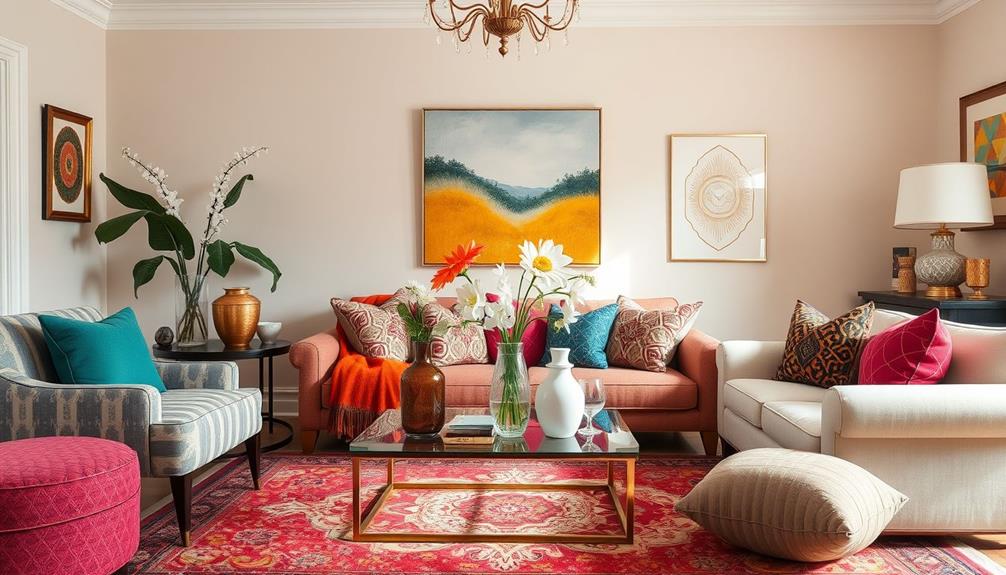
When you accessorize your home, each piece should resonate with your personal style and interests, making the space feel uniquely yours.
Start by choosing accessories that reflect who you are—think art, textiles, or unique collections. This creates a cohesive and meaningful environment.
To elevate your design, layer different textures and materials. Use woven throws, metallic accents, or soft fabrics to add depth and visual interest.
Stick to a limited color palette for your accessories, ensuring each piece complements your overall design theme.
Here are a few tips to keep in mind:
- Invest in statement pieces: Oversized art or unique lighting fixtures can serve as focal points.
- Swap out smaller accessories seasonally: Changing cushions or decorative objects can refresh your space without a full redesign.
- Mix and match textures: Combining various materials keeps your design dynamic and engaging.
Conclusion
Now that you've got the tools to design your own space, it's time to put your plan into action. Remember, just like a vintage record player spinning your favorite tunes, your home should reflect your personal vibe. Embrace the process, enjoy each step, and don't be afraid to make adjustments along the way. With creativity and a little patience, you'll transform your house into a cozy haven that feels just like you. Happy designing!
